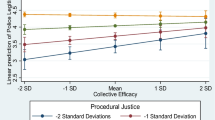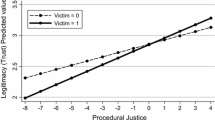Abstract
This study examines how residents from a high-crime, high-poverty neighborhood in East Baltimore interact with one another, participate in their community, and perceive police. Using community surveys collected from 191 respondents, the study empirically measures collective efficacy, community participation, and police services and encounters. We predict that high levels of collective efficacy lead to more positive perceptions of police and an increased willingness to work with law enforcement. The results indicate that neighborhood trust is an important factor in shaping a community’s overall perception of police. Furthermore, older residents who own their homes are more likely to report a more positive perception of police, specifically police response.
Similar content being viewed by others
Notes
On blocks with five or less residential properties, we include all properties in the sample.
This includes eight residents who spoke Spanish and were unable to communicate with the survey team.
References
Altergott, K. 1988. Social action and interaction in later life: Aging in the United States. In Daily life in later life: Comparative perspectives, ed. K. Altergott, 117–146. Thousand Oaks, CA: Sage Publications.
Bandura, A. 1975. The ethics and social purposes of behavior modification. In Annual review of behavior therapy theory and practice, vol. 3, ed. C.M. Franks and G.T. Wilson. New York: Brunner/Mazel.
Brown, B., and D. Perkins. 1992. Disruptions in place attachments. In Place attachment, ed. I. Altman and S. Low, 279–304. New York: Plenum Press.
Brown, G., B.B. Brown, and D.D. Perkins. 2004. New housing as neighborhood revitalization: Place attachment and confidence among residents. Environment and Behavior 36 (6): 749–775.
Brown, B., D.D. Perkins, and G. Brown. 2003. Place attachment in a revitalizing neighborhood: Individual and block level analysis. Journal of Environmental Psychology 23: 259–271.
Brunson, R. 2007. “Police don’t like Black people”: African American young men’s accumulated police experiences. Criminology and Public Policy 6: 71–102.
Burgess, E.W. 1925. The growth of the city. In The city, ed. R.E. Park, E.W. Burgess, and R.D. MacKenzie. Chicago, IL: University of Chicago Press.
Cao, L., J. Frank, and F.T. Cullen. 1996. Race, community context and confidence in the police. American Journal of Police 15 (1): 3–22.
Cohen-Callow, A., K. Hopkins, M. Meyer, and S. Iyer. 2014. Evaluation: Baltimore community foundation target neighborhood initiative. Baltimore, MD: Prepared for the Baltimore Community Foundation.
Decker, S.H. 1981. Citizen attitudes toward the police: A review of past findings and suggestions for future policy. Journal of Police Science and Administration 9: 80–87.
Ekins, E. 2016. Policing in America: Understanding public attitudes toward that police. Cato Institute: Results from a national survey.
Engel, R.S. 2005. Citizens’ perceptions of injustice during traffic stops with police. Journal of Research in Crime & Delinquency 42: 445–481.
Gau, J.M., N. Corsaro, E.A. Stewart, and R.K. Brunson. 2012. Examining macrolevel impacts on procedural justice and police legitimacy. Journal of Criminal Justice 40: 333–343.
Hagan, J., C. Shedd, and M.R. Payne. 2005. Race, ethnicity and youth perceptions of criminal injustice. American Sociological Review 70: 381–407.
Hawdon, J., and J. Ryan. 2003. Police-resident interactions and satisfaction with police: An empirical test of community policing assertions. Criminal Justice Policy Review 14: 55–74.
Homant, R.J., D.B. Kennedy, and R.M. Fleming. 1984. The effect of victimization and the police response on citizens attitudes to the police. Journal of Police Science and Administration 12: 323–332.
Iyer, S., C. Knott, and A. Cantora. 2013. McElderry park: Community plan for crime reduction. Baltimore Neighborhood Indicators Alliance, Jacob France Institute, University of Baltimore. http://www.bniajfi.org/wp-content/uploads/2015/03/McElderry-Park-BCJI-Plan-Year-1-Final.pdf. Accessed Nov 2018.
Iyer, S., C. Knott, and A. Cantora. 2015. McElderry park: Byrne criminal justice innovation grant. Final report for year 2 funding (2014–2015). Baltimore Neighborhood Indicators Alliance, Jacob France Institute, University of Baltimore. http://www.bniajfi.org/wp-content/uploads/2016/05/BCJI%20Year%202%20Report%20FINAL.pdf. Accessed Nov 2018.
Iyer, S., C. Knott, and A. Cantora. 2016. McElderry park: Byrne criminal justice innovation grant. Final report for year 3 funding (2015–2016). Baltimore Neighborhood Indicators Alliance, Jacob France Institute, University of Baltimore. http://bniajfi.org/wp-content/uploads/2017/05/BCJI-Year-3-Report.pdf. Accessed Nov 2018.
Janowitz, M. 1975. Sociological theory and social control. American Journal of Sociology 81: 82–108.
McDonald, J., and R.J. Stiokes. 2006. Race, social capital, and trust in police. Urban Affairs Review 41: 358–375.
Merry, S., N. Power, M. McManus, and L. Alison. 2011. Drivers of public trust and confidence in police in the UK. International Journal of Police Science & Management 14 (2): 118–135.
Nix, J., S.E. Wolfe, J. Rojek, and R.J. Kaminski. 2015. Trust in the police: The influence of procedural justice and perceived collective efficacy. Crime & Delinquency 61 (4): 610–640.
O’Connor, C.D. 2008. Citizen attitudes toward the police in Canada. Policing: An International Journal of Police Strategies & Management 31 (4): 578–595.
Oh, J. 2003. Social bonds and the migration intentions of elderly urban residents: The mediating effect of residential satisfaction. Population Research and Policy Review 22: 127–146.
Perkins, M. 2016. Modelling public confidence of the police: How perceptions of the police differ between neighborhoods in a city. Police Practice and Research 17 (2): 113–125.
Reiss Jr., A.J. 1971. Systematic observations of natural social phenomena. In Sociological methodology, vol. 3, ed. Herbert Costner. San Francisco, CA: Jossey-Bass.
Ren, L., L. Cao, N. Lovrich, and M. Gaffney. 2005. Linking confidence in the police with the performance of the police: Community policing can make a difference. Journal of Criminal Justice 33: 55–66.
Sampson, R. 2012. Great American city. Chicago, IL: University of Chicago Press.
Sampson, R.J., and S.W. Raudenbush. 1999. Systematic social observation of public spaces: A new look at disorder in urban neighborhoods. American Journal of Sociology 105: 603–651.
Sampson, R.J., S. Raudenbush, and F. Earls. 1997. Neighborhoods and violent crime: A multilevel study of collective efficacy. Science 277: 918–924.
Schaefer Center for Public Policy. 2012. Baltimore city citizen survey. University of Baltimore. Retrieved from https://finance.baltimorecity.gov/sites/default/files/citizensurvey.pdf. Accessed Nov 2018.
Schuck, A.M., D.P. Rosenbaum, and D.F. Hawkins. 2008. The influence of race/ethnicity, social class, and neighborhood context on residents’ attitudes toward the police. Police Quarterly 11: 496–519.
Shaw, C.R., and H.D. McKay. 1942. Juvenile delinquency and urban areas. Chicago, IL: University of Chicago. (Reprint ed., 1969).
Sunshine, J., and T.R. Tyler. 2003. The role of procedural justice and legitimacy in shaping public support for policing. Law & Society Review 37: 513–548.
Taylor, R.B. 1996. Neighborhood responses to disorder and local attachments: The systemic model of attachment, social disorganization, and neighborhood use value. Sociological Forum 11 (1): 41–74.
Thibaut, J., and L. Walker. 1975. Procedural justice: A psychological analysis. Hillsdale, NJ: Lawrence Erlbaum.
Thrasher, F.M. 1927. The gang: A study of 1,313 gangs in Chicago. Chicago, IL: Phoenix Books. (Abridged ed., 1963).
Tyler, T.R. 1990. Why people obey the law. New Haven, CT: Yale University Press.
Tyler, T.R. 2005. Policing in Black and White: Ethnic group differences in trust and confidence in the police. Police Quarterly 8: 322–342.
Uchida, C.D., M.L. Swatt, S.E. Solomon, and S. Sean Varano. 2014. Neighborhoods and crime: Collective efficacy and social cohesion in Miami-Dade County. U.S. Department of Justice. Retrieved from: https://www.ncjrs.gov/pdffiles1/nij/grants/245406.pdf. Accessed Nov 2018.
Van Craen, M. 2015. Understanding police officers’ trust and trustworthy behavior: A work relations framework. European Journal of Criminology 13 (2): 274–294.
Weitzer, R., and S.A. Tuch. 2002. Perceptions of racial profiling: Race, class, and personal experience. Criminology 40: 435–457.
Weitzer, R., and S.A. Tuch. 2005. Determinants of public satisfaction with the police. Police Quarterly 8: 279–297.
Wilson, J.Q., and G. Kelling. 1982. The police and neighborhood safety: Broken windows. The Atlantic Monthly 127: 29–38.
Wu, Y., I.Y. Sun, and R.A. Triplett. 2009. Race, class or neighborhood context: Which matters more in measuring satisfaction with police. Justice Quarterly 26: 125–156.
Zaccaro, S.J., U. Blair, C. Peterson, and M. Zazanis. 1995. Collective efficacy. In Self-efficacy, adaptation, and adjustment, ed. J.E. Maddux, 305–328. New York: Plenum.
Author information
Authors and Affiliations
Corresponding author
Additional information
Publisher's Note
Springer Nature remains neutral with regard to jurisdictional claims in published maps and institutional affiliations.
Rights and permissions
About this article
Cite this article
Cantora, A., Wasileski, G., Iyer, S. et al. Examining collective efficacy and perceptions of policing in East Baltimore. Crime Prev Community Saf 21, 136–152 (2019). https://doi.org/10.1057/s41300-019-00065-7
Published:
Issue Date:
DOI: https://doi.org/10.1057/s41300-019-00065-7




